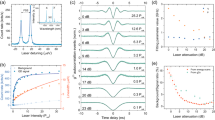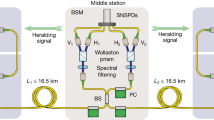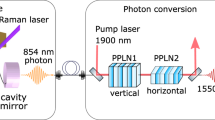Abstract
Efficient fibre-based long-distance quantum communication via quantum repeaters relies on deterministic single-photon sources at telecom wavelengths, potentially exploiting the existing world-wide infrastructures. For upscaling the experimental complexity in quantum networking, two-photon interference (TPI) of remote non-classical emitters in the low-loss telecom bands is of utmost importance. Several experiments have been conducted regarding TPI of distinct emitters, for example, using trapped atoms1, ions2, nitrogen vacancy centres3,4, silicon vacancy centres5, organic molecules6 and semiconductor quantum dots7,8. However, the spectral range was far from the highly desirable telecom C-band. Here, we exploit quantum frequency conversion to realize TPI at 1,550 nm with single photons stemming from two remote quantum dots. We thereby prove quantum frequency conversion9,10,11 as a bridging technology and a precise and stable mechanism to erase the frequency difference between independent emitters. On resonance, a TPI visibility of 29 ± 3% has been observed, limited only by the spectral diffusion processes of the individual quantum dots12,13. The local fibre network used covers several rooms between two floors of the building. Even the addition of up to 2 km of fibre channel shows no influence on the TPI visibility, proving the photon wavepacket distortion to be negligible. Our studies pave the way to establish long-distance entanglement distribution between remote solid-state emitters including interfaces with various quantum hybrid systems14,15,16.
This is a preview of subscription content, access via your institution
Access options
Access Nature and 54 other Nature Portfolio journals
Get Nature+, our best-value online-access subscription
$29.99 / 30 days
cancel any time
Subscribe to this journal
Receive 12 print issues and online access
$259.00 per year
only $21.58 per issue
Buy this article
- Purchase on Springer Link
- Instant access to full article PDF
Prices may be subject to local taxes which are calculated during checkout




Similar content being viewed by others
Data availability
The data that support the plots within this paper and other findings of this study are available from the corresponding author upon reasonable request.
References
Beugnon, J. et al. Quantum interference between two single photons emitted by independently trapped atoms. Nature 440, 779–782 (2006).
Maunz, P. et al. Quantum interference of photon pairs from two remote trapped atomic ions. Nat. Phys. 3, 538–541 (2007).
Bernien, H. et al. Two-photon quantum interference from separate nitrogen vacancy centers in diamond. Phys. Rev. Lett. 108, 043604 (2012).
Sipahigil, A. et al. Quantum interference of single photons from remote nitrogen-vacancy centers in diamond. Phys. Rev. Lett. 108, 143601 (2012).
Sipahigil, A. et al. Indistinguishable photons from separated silicon-vacancy centers in diamond. Phys. Rev. Lett. 113, 113602 (2014).
Lettow, R. et al. Quantum interference of tunably indistinguishable photons from remote organic molecules. Phys. Rev. Lett. 104, 123605 (2010).
Patel, R. B. et al. Two-photon interference of the emission from electrically tunable remote quantum dots. Nat. Photon. 4, 632–635 (2010).
Flagg, E. B. et al. Interference of single photons from two separate semiconductor quantum dots. Phys. Rev. Lett. 104, 137401 (2010).
Zaske, S. et al. Visible-to-telecom quantum frequency conversion of light from a single quantum emitter. Phys. Rev. Lett. 109, 147404 (2012).
Ates, S. et al. Two-photon interference using background-free quantum frequency conversion of single photons emitted by an InAs quantum dot. Phys. Rev. Lett. 109, 147405 (2012).
Kambs, B. et al. Low-noise quantum frequency down-conversion of indistinguishable photons. Opt. Express 24, 22250 (2016).
Robinson, H. D. & Goldberg, B. B. Light-induced spectral diffusion in single self-assembled quantum dots. Phys. Rev. B 61, R5086–R5089 (2000).
Kuhlmann, A. V. et al. Charge noise and spin noise in a semiconductor quantum device. Nat. Phys. 9, 570–575 (2013).
De Greve, K. et al. Quantum-dot spin–photon entanglement via frequency downconversion to telecom wavelength. Nature 491, 421–425 (2012).
Maring, N. et al. Photonic quantum state transfer between a cold atomic gas and a crystal. Nature 551, 485–488 (2017).
Bock, M. et al. High-fidelity entanglement between a trapped ion and a telecom photon via quantum frequency conversion. Nat. Commun. 9, 1998 (2018).
Sangouard, N. et al. Long-distance entanglement distribution with single-photon sources. Phys. Rev. A 76, 050301 (2007).
Michler, P. Quantum Dots for Quantum Information Technologies (Springer International, Cham, 2017).
Loredo, J. C. et al. Scalable performance in solid-state single-photon sources. Optica 3, 433–440 (2016).
Wang, H. et al. Near-transform-limited single photons from an efficient solid-state quantum emitter. Phys. Rev. Lett. 116, 213601 (2016).
Lenzini, F. et al. Active demultiplexing of single photons from a solid-state source. Laser Photonics Rev. 11, 1600297 (2017).
Wang, H. et al. High-efficiency multiphoton boson sampling. Nat. Photon. 11, 361–365 (2017).
Yu, L. et al. Two-photon interference at telecom wavelengths for time-bin-encoded single photons from quantum-dot spin qubits. Nat. Commun. 6, 8955 (2015).
Felle, M. et al. Interference with a quantum dot single-photon source and a laser at telecom wavelength. Appl. Phys. Lett. 107, 131106 (2015).
Legero, T., Wilk, T., Kuhn, A. & Rempe, G. Time-resolved two-photon quantum interference. Appl. Phys. B 77, 797–802 (2003).
Kambs, B. & Becher, C. Limitations on the indistinguishability of photons from remote solid state sources. Preprint at https://arxiv.org/abs/1806.08213 (2018).
Weber, J. H. et al. Overcoming correlation fluctuations in two-photon interference experiments with differently bright and independently blinking remote quantum emitters. Phys. Rev. B 97, 195414 (2018).
Lenhard, A. et al. Single telecom photon heralding by wavelength multiplexing in an optical fiber. Appl. Phys. B 122, 20 (2016).
Sun, Q.-C. et al. Entanglement swapping over 100 km optical fiber with independent entangled photon-pair sources. Optica 4, 1214–1218 (2017).
Cuevas, A. et al. Long-distance distribution of genuine energy-time entanglement. Nat. Commun. 4, 2871 (2013).
Vural, H. et al. Two-photon interference in an atom–quantum dot hybrid system. Optica 5, 367 (2018).
He, Y.-M. et al. On-demand semiconductor single-photon source with near-unity indistinguishability. Nat. Nanotech. 8, 213–217 (2013).
Somaschi, N. et al. Near-optimal single-photon sources in the solid state. Nat. Photon. 10, 340–345 (2016).
Sangouard, N., Simon, C., de Riedmatten, H. & Gisin, N. Quantum repeaters based on atomic ensembles and linear optics. Rev. Mod. Phys. 83, 33–80 (2011).
Portalupi, S. L. et al. Simultaneous Faraday filtering of the Mollow triplet sidebands with the Cs-D1 clock transition. Nat. Commun. 7, 13632 (2016).
Acknowledgements
The authors thank T. Herzog for the installation of the telecom fibre links. The authors also thank M. Bock for discussions and advice during preparation of the QFC set-ups. This work was financially supported by the Deutsche Forschungsgemeinschaft (DFG) via projects MI 500/26-1 and BE 2306/6-1, as well as by the German Federal Ministry of Science and Education (Bundesministerium für Bildung und Forschung, BMBF) within project Q.com (contract nos. 16KIS0115 and 16KIS0127). The research of IQST is supported financially by the Ministry of Science, Research and Arts Baden-Württemberg.
Author information
Authors and Affiliations
Contributions
J.H.W., B.K., S.K. and S.L.P. performed the experiment with the support of J.K. B.K. built the frequency converters. M.J. provided the samples. J.H.W. and B.K. analysed the data. B.K., H.V. and J.M. set up the theoretical model. J.M. and H.V. conducted the numerical simulations. J.H.W., S.L.P. and B.K. wrote the manuscript with support from P.M. and input from all authors. P.M. and C.B. coordinated the project. All authors actively took part in all scientific discussions.
Corresponding authors
Ethics declarations
Competing interests
The authors declare no competing interests.
Additional information
Publisher’s note: Springer Nature remains neutral with regard to jurisdictional claims in published maps and institutional affiliations.
Supplementary information
Supplementary Material
Supplementary text, supplementary figures 1 and 2
Rights and permissions
About this article
Cite this article
Weber, J.H., Kambs, B., Kettler, J. et al. Two-photon interference in the telecom C-band after frequency conversion of photons from remote quantum emitters. Nature Nanotech 14, 23–26 (2019). https://doi.org/10.1038/s41565-018-0279-8
Received:
Accepted:
Published:
Issue Date:
DOI: https://doi.org/10.1038/s41565-018-0279-8
This article is cited by
-
Nonlinear and quantum photonics using integrated optical materials
Nature Reviews Materials (2024)
-
Ultra-narrow inhomogeneous spectral distribution of telecom-wavelength vanadium centres in isotopically-enriched silicon carbide
Nature Communications (2023)
-
Telecom-band quantum dot technologies for long-distance quantum networks
Nature Nanotechnology (2023)
-
Frequency-insensitive spatiotemporal shaping of single photon in multiuser quantum network
npj Quantum Information (2023)
-
Applications of single photons to quantum communication and computing
Nature Reviews Physics (2023)



